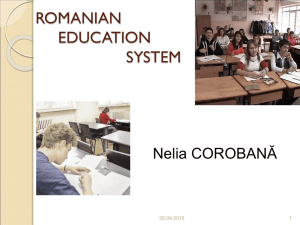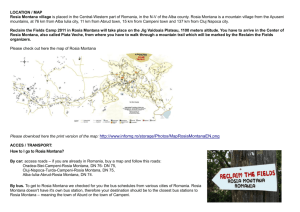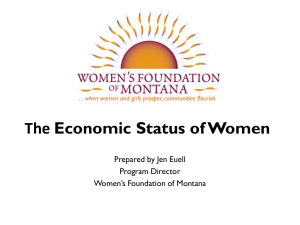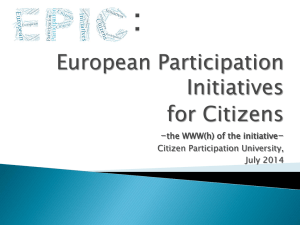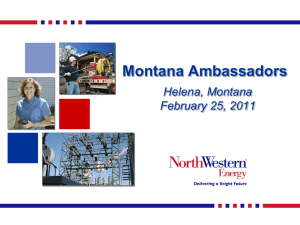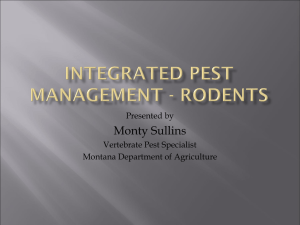paper cuglesan / herbel / nicula - cepsa.at || CENTRAL EUROPEAN
advertisement
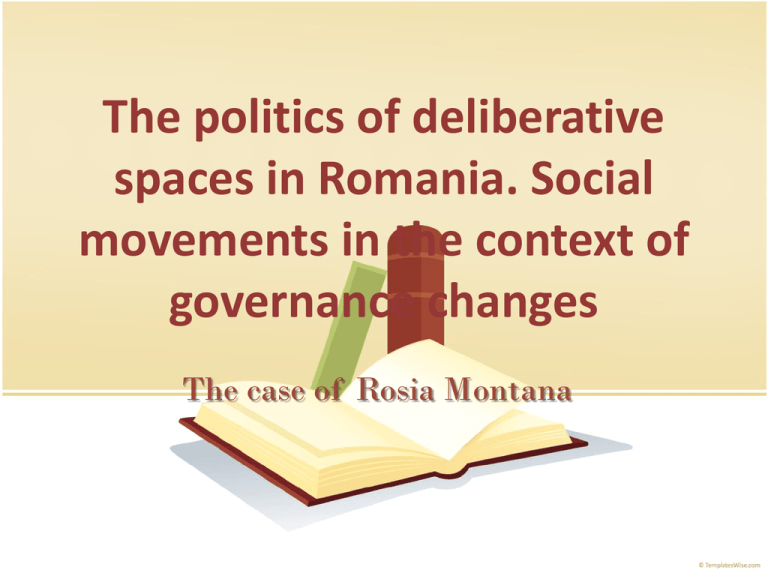
The politics of deliberative spaces in Romania. Social movements in the context of governance changes The case of Rosia Montana Natalia Cugleşan, PhD natalia_cuglesan@yahoo.com Alin Nicula, PhD alin_nicula@yahoo.com Mihaela Herbel, PhD candidate Research supported through mihaela.herbel@ubbcluj.ro Acknowledgements Jean Monnet Module Multilevel governance in the European Union Investing in people! Ph.D. scholarship, Project co-financed by the SECTORAL OPERATIONAL PROGRAM FOR HUMAN RESOURCES DEVELOPMENT 2007 - 2013 Priority Axis 1. "Education and training in support for growth and development of a knowledge based society" Key area of intervention 1.5: Doctoral and post-doctoral programs in support of research. Contract nr.: POSDRU/88/1.5/S/60185 – “INNOVATIVE DOCTORAL STUDIES IN A KNOWLEDGE BASED SOCIETY” Babeş-Bolyai University, Cluj-Napoca, Romania Notice • A prior version of this paper was delivered at Multilevel governance in the wider Europe: taking ‘governance’ seriously, Centre for European Law and Governance, Law School, Cardiff University, 7 and 8 July 2011 • This research constitutes the core of Mihaela Herbel’s project for the Robert Bosch Junior Fellowship at the Institute for Human Sciences in Vienna (November 2011-April 2012) Presentation outline • Objectives of the research • Section 1: deliberative spaces in Romania in the context of governance changes • Section 2: civil society actors and their involvement in the Rosia Montana case • Conclusions • Future research directions Section 1: decentralization process in Romania, civil society and environmental policy The Economic and Social Council. The set-up of a deliberative space? • Set up in 1997 by the law no.109/1997 as a national autonomous public institution • Modified and completed through the law 491/2001 andLaw 58/2003 ; • In the constitution of 2003 is mentioned as a consultative body of the Government and the Parliament • Reorganised by the law 62/2011(the law of social dialogue) The Economic and Social Council. The set-up of a deliberative space? • • • • • • Promotion of social justice Equal membership: government, trade unions and employers Corporatist formula even if Romania is not a corporatist state Civil society organisations were not represented within the ESC until 2011 No similiarities with the Economic and Social Council at EU level After 2007, the number of representatives was rised at 45 in order to appoint Romania’s representatives within the Economic and Social Council • Not a true consultative body as long as the government is represented within the ESC and it should take decisions based on the Council’s reccomendations • this was solved only through the Law 62/2011 The Law 62/2011: How much deliberation it ads? • Membership: No more representatives of the government, but The government still retains control over the ESC as it appoints the civil society representatives The trade unions and the employer’s organisations apppoint their own representatives The Economic and Social Council – structure and competences • 9 sectoral comitees • The legislative proposals in the Parliament are also submitted and analyzed by these comitees • The Committee on Agriculture, Rural Development and Environment has not offered yet any public position on Rosia Montana Section 2: civil society actors and their involvement in the Rosia Montana case Objectives of the research 1.To contribute to the quite reduced body of literature concerning governance and civil society Eastern Europe after 1989, with a research focus on Romania 2.To explore within a single case the relationship between political contestation and political deliberation in Romanian system of governance How are we fulfilling our objectives? • Through looking at the case of the Rosia Montana mining project and the activity of the civil society in this case • We looked at their activities for the past decade (2000-2011), trying to find a pattern of strategic (inter)action • we look specifically to “unpack” the framing of the Rosia Montana case by the civil society through a discourse analysis Methodology (I) • This is an early-stage research • The purpose is to map the case • We map the case through grounded theory (Anselm and Strauss, The discovery of grounded theory, 1967) Methodology (II) Grounded theory • • • • From the sociology of illness Abductive paradigm No literature reviews, no talking Ethnography, story-telling and narration Grounded theory and our research • Rosia Montana is discussed in many disciplinary fields, from environmental studies to sociology • The case has not been discussed yet in the disciplinary perspective of political science with a focus on civil society participation in decision making process • The case has not been discussed in the wider context of Europeanization in Central and Eastern Europe after 1989 • The case has not been discussed in the context of civil society’s means of collective action • Our research explores the similarities between the means of collective action of civil society organizations before and after 1989 Grounded theory application. What did we do? • Sources: press, online, tapes of consultations in Rosia Montana (summer 2006) • We looked at these sources and identified a critical period of ten years (2001-2011) – key moment 2007 (Romania’s accession to the EU) • We compared the messages of civil society organizations, the mining company and the state authorities with a focus on the civil society Grounded theory application. What did we do? • We tried to explain the civil society’s discourse and means of collective action through looking at several social movements that outburst in Romania in the same time frame (Save Vama Veche, Save Danube Delta) • As we found all these movements followed a cultural heritage narrative, we tried to understand why • So we looked to the social movements during the communist rule and we understood Rosia Montana –some facts • The largest gold mine in Europe (if the project is going to start) • Main reason of contestation on environmental grounds – using cyanide as a method of processing • Other reasons for contestation: the cultural heritage issue at Rosia Montana – the ancient roman mine Actors involved full time 2000-2011 Rosia Montana Gold Corporation or Gabriel Resources The Romanian state – central and local level Civil society organizations -Australian/ Canadian mining company -Contested ownership -Has leased the area for 25 years from the Romanian state -20% participation in the mining project –publicprivate partnership -contest the mining project -champion the including of the ancient roman mine on the UNESCO HERITAGE WORLD list as a mean of stopping the project Actors involved – sequentially • Friends of the Earth – NGO global coalition they lobbied against an agency of the World Bank investing in the project -2007 • Hungary –has overtly expressed it’s opposition towards the project : in case of an ecological disaster it would be heavily affected • Greenpeace – they included for some time the Rosia Montana issue on their European agenda Intermezzo: the history and politics of Hungary’s opposition 1. History • 2000- Baia Mare- the cyanides lake at the “Aurul” Company broke down • This affected the entire basin of the Tisza river and got even to the Danube 2. Politics: • The Hungarian MPs in the European Parliament have lobbied against the cyanide usage in mining in the EU – from 2006 • Some Romanian MPs in the EP curiously sustain mining with cyanides Values and beliefs of the actors The company and the state Civil society Sustainable growth perspective– use cyanides if you ensure protecting measures Sustainable development perspective– do not use cyanides at all, close off the project Campaign for job creation, corporate social responsibility Campaign mainly for the inclusion of the cultural heritage site at Rosia Montana on the UNESCO list of protected sites A puzzling finding • The Civil society organizations prefer the cultural heritage narrative over the ecological narrative even if the ecological narrative could mobilize more support at European level, as the EU has a strong environmental policy and a very weak cultural heritage policy Spaces for political contestation International level (UNESCO) – cultural heritage narrative European level (the environmental policy) – corresponds to the ecological narrative Some possible explanations: • the modes of collective action revolve around mobilizing support at national level through: Music festivals Graffiti protests Bearing a cultural and social message rather than an environmental one • These modes are not workable mechanisms if you want to count as civil society actor in the European environmental policy • But still, these means of collective action are consecrated in Romania since the communist rule, when cultural narrative was the only way of performing political contestation Conclusions 1. The environmental civil society in Romania uses cultural means of political contestation 2. These means are similar with the ones used by the social movements during the communist rule 3. Civil society organizations in Romania involved in the Rosia Montana issue are caught in a prisoner's dilemma: • In order to produce political mobilization at the international level, an ecological/environmental message would be more suitable • In order to construct political mobilization in the domestic context, a cultural heritage narrative seems to be more suitable Future research directions • We used grounded theory in order to map the main directions within the case study • But how do we develop our research in the disciplinary field of political science? Which brings us to… Possible theoretical frameworks: Multi-level governance (Marks and Hooghe) Multilevel governance. A type comparison Type 1 Type 2 Exclusive exercise of authority over the territorial levels Specialized, multiple and independent authorities, territorially overleaped excludes authority overleap More authorities a limited number of administrative levels over which authority is dispersed More administrative levels a cvasi-permanent architecture of MLG A more flexible architecture Why multi-level governance does not explain our case? • MLG explains the insertion of non-state actors into a certain political field • MLG contains assumptions regarding the consultation and negotiation process • But if the consultation process is monopolized by the state, MLG does not provide us with explicative tools in order to infer the behavior of civil society actors Institutional Analysis and Development framework (Ostrom) Clusters of variables Biophysical, community and institutionak c characteristics within the IAD Action arena in IAD Patterns of interaction in IAD Seeing the Rosia Montana case through the lens of the IAD 1. Rules in use – look at constitutional factors of the situation • The rules-in-use could offer an explanation regarding the patterns of interaction in the Rosia Montana case • The civil society uses certain means of collective action (cultural) as because these are the means used traditionally by the civil society in Romania or because • It is used with being ignored or instrumentalised by the state Seeing the Rosia Montana case through the lens of the IAD 2. Action arena – looks at the incentives of the actors • The civil society uses certain means of collective action as doing so it can construct more political mobilization at domestic level, as well as because it has better chance to increase it’s visibility/impact Conclusion • These variables are going to be explored within our field research, based on in-depth interviews. Suggestions and questions time Thank you for your attention!
